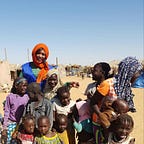Feeding the future in Timbuktu
Journey to the heart of the Sahel where school feeding is helping to keep children in school in an ancient citadel of knowledge
Timbuktu on my mind. As I board the United Nations Humanitarian Air Service (UNHAS) flight to Timbuktu, I can’t help thinking about all the stories told and written about the place: the city of 333 saints, the mysterious, Timbuktu!
As we fly over Timbuktu, its beauty is striking, and more than justifies its nickname as the “pearl of the desert”. The city, which in 1988 became a UNESCO world heritage site thanks to its cultural and historical importance, continues to inspire poets around the world as well as those on the lookout for gold.
I am not in Timbuktu today to look for gold or salt. I’m here with colleagues from the World Food Programme (WFP) to visit a school. In doing so, I tell myself that the illustrious residents of past centuries would be proud. In its heyday this city was a cradle of learning in Africa.
The real treasure of Timbuktu consists of a collection of manuscripts from the West African imperial period, which demonstrates the vital importance of education and knowledge in this city over the centuries.
I am drawn to its small streets and taken aback by the hospitality of everyone I meet as we meander through the city. After a short drive, we are there! The Kabara elementary school…
The front of the school is very sandy, with two large buildings in the distance, each home to three classes of schoolchildren. Only the voices of the teachers pierce the silence here.
The school’s head teacher, Nia Coulibaly, welcomes us for a small discussion accompanied by Hamidou Cissé of the Teachers’ Resource Centre — a local government authority — who visits the school every two days to ensure everything is running smoothly.
“The school has been around since 2006 but we suffered from low enrollment rates, especially among girls,” Coulibaly tells us. “Many parents would rather keep kids at home for housework or push them to become hawkers …”she adds
In Mali, the education sector continues to face many challenges related to children’s access to education, retention rates, and the quality of education.
It is estimated that 1.2 million children between the ages of 7 and 12 are still outside the school system, which is almost 50% of the primary school age population. Girls from rural areas or those living in the poorest households are most at risk of not being able to attend school.
It may be tough, in this context, for Mali to achieve Sustainable Development Goal (SDG) 4, which seeks to ensure access to quality education. But school feeding could be part of the solution.
WFP, which is contributing to Mali’s efforts to achieve SDG 2 to end hunger, is supporting authorities to encourage schoolchildren living in areas vulnerable to food insecurity or with low enrollment rates to attend classes through school feeding activities.
“Since we started school feeding in 2012, families who were reluctant to send children to school for financial issues or due to long distances between home and school are doing so now,” Coulibaly says.
After receiving food items directly over the years, the Kabara school in Timbuktu now runs its feeding activities by buying items from local markets.
“We love cash because it allows us to respect the children’s eating preferences while offering them a wide choice of dishes every week. Cash is the desire and choice of the children,” says Coulibaly enthusiastically.
School feeding falls into the adaptive social protection framework, providing access to education, health and nutrition.It helps families support their children’s education while protecting their food security.
“Today, I am a mother and a happy director because out of 342 students, 172 are girls and they rank first in many of the classes,” adds the head teacher.
“Come with me, I’ll show you!” she tells us as she heads for Grade 6.
“Let me introduce you to Aicha Oumar, she is 12 years old, she is top of her class, and school meals strongly encouraged her parents to send her here”, states Coulibaly.
Aicha greets us with a smile.
“My mum tells me that she is proud of me as she did not have the opportunity to study, which is a big encouragement! She is very happy when I come back with good grades,” Aicha says.
“I’m very happy to be able to eat at school every afternoon, so I can work better in class and play with my friends during the break. I come home in the evening after classes,” she adds.
Finally, it is 12:00, time for lunch! On the menu today is the “zamai” — rice that the students love.
After washing their hands, students settle down to eat lunch while discussing classes and what games they could play during the next break.
I sit down with Aicha to get to know her better.
“Before, my mum was a little worried because I have morning and afternoon classes and she did not know how I could have lunch. Now she is reassured, I often tease her saying that the meals at school are tastier!” Aicha tells me. “I eat well without having to go home every afternoon, which is helpful as our house is a bit far,” she adds.
“When I grow up, I want to become a teacher to pass on all that I have learned to other children, my parents are proud of me and that makes me happy.”
It is on this note of hope for the future of Mali that we leave the school of Kabara with a last picture of Mrs. Coulibaly and her students.
School feeding in Mali is implemented thanks to the financial support of Germany, Italy, Mastercard, Monaco, Luxembourg and the European Union.
Learn more about WFP’s work in Mali
